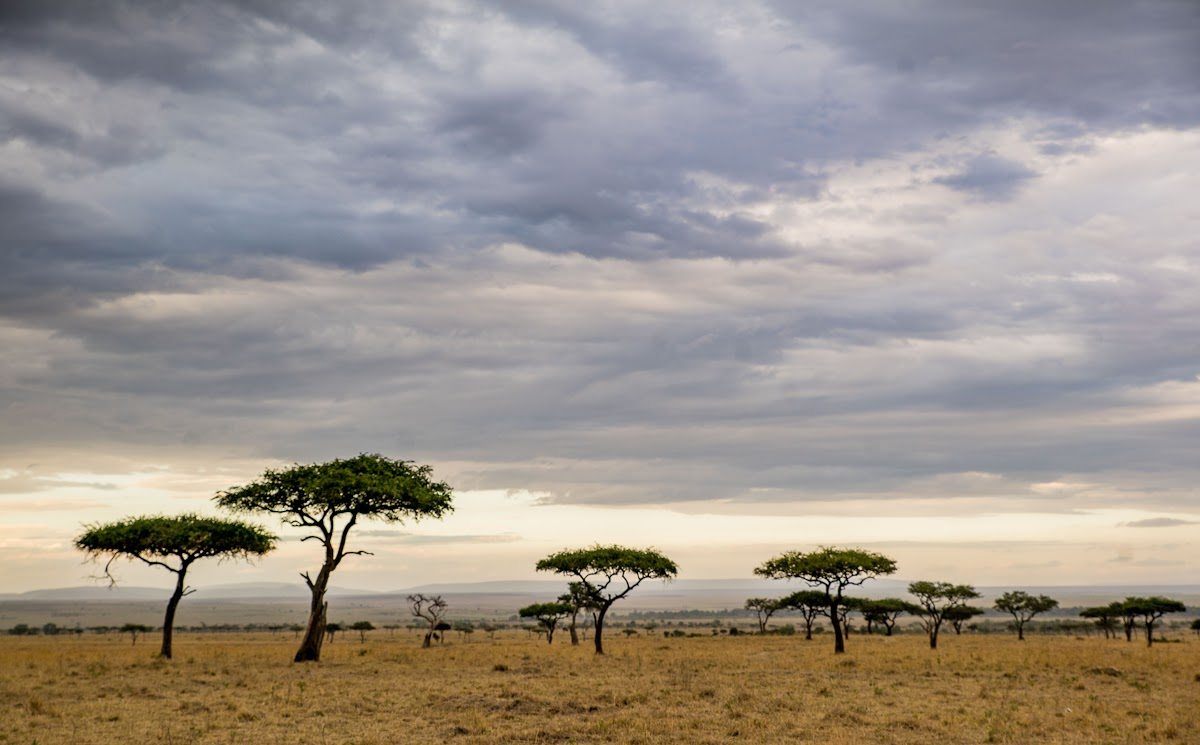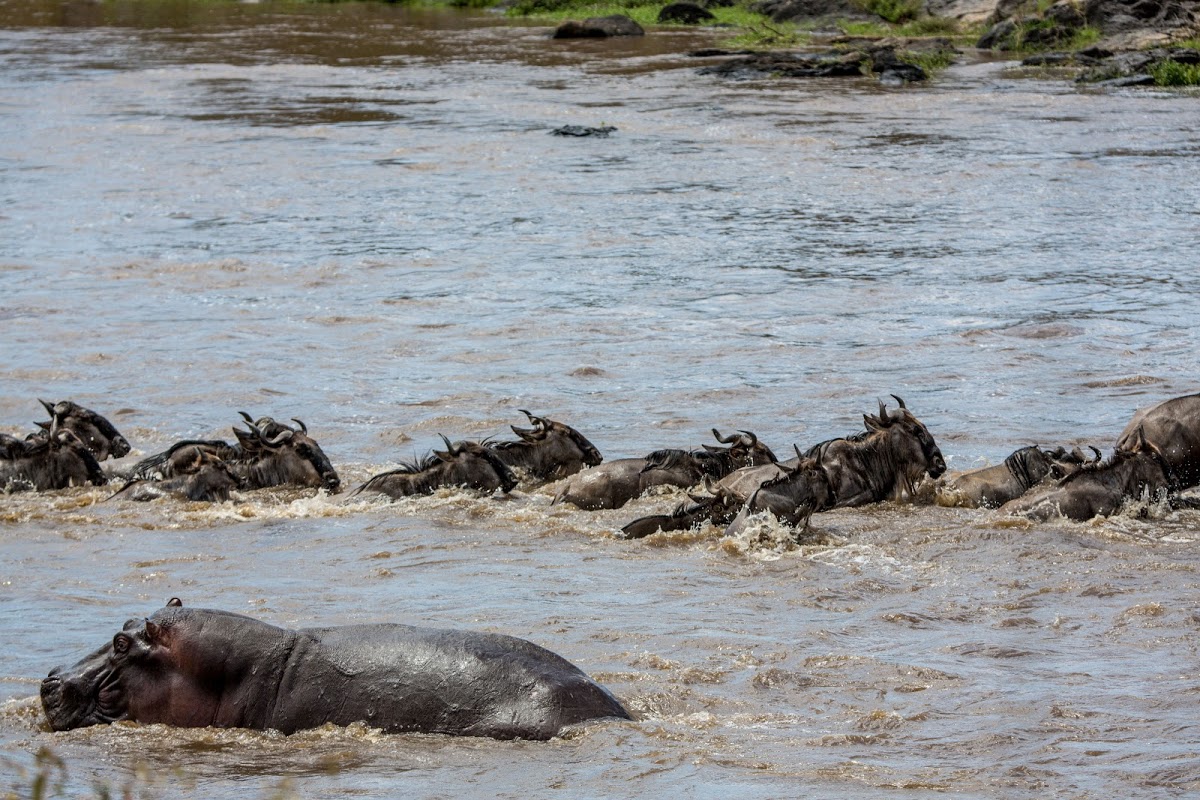Our second crossing was a hit-and-miss (as are many, I had now come to learn). Two days after our first sighting, Johnathan, Sean, and I were scouting the Mara River’s banks for the second consecutive day when our safari vehicle’s radio crackled with activity, alerting us to a crossing a few hundred metres away. We were off. Speeding and veering and bouncing along.

But we were too late.
The only evidence that there had been a Mara River crossing at all, much to my dismay, was the presence of four wildebeest heads just visible on a muddy section of the bank across from us. The herd and their furiously kicking hooves had turned the mud into quicksand, and these last four were the stragglers who had sunk, unable to break free, their bodies submerged and left behind by the rest of the herd.

By this point, I thought I’d seen it all and so when our last three days in East Africa took us from the Serengeti in Tanzania to Kenya‘s Mara Conservancies, I couldn’t fathom that there could possibly be more to see. But, I had to remind myself, this was Africa, and she was anything but predictable.

Our plane lifted off from Migori Airstrip, and flew the 70km south-east it was until we reached our next destination. Our 12-seater aircraft flew so low, it felt like we were just skimming the treetops before the earth fell away as we soared over the Oloololo Escarpment. The landscape changed dramatically from the lush greenery of before. All that lay ahead of us was an endless acacia-dotted savannah.

We landed without incident at the dusty Kichwa Tembo Airstrip (our pilots had nonchalantly warned us about often having to abort landings last minute due to the odd giraffe or lounging lion on the runway). We were greeted by Eric, our young Maasai ranger, and Bateleur Camp‘s manager, Chris, who I came to know by his favourite phrase “Hakuna Matata!” which was always followed by a booming belly laugh.

After a welcome drink and a chat about our travels up until that point, we were ready to safari. “Twinde!”, Eric exclaimed, clapping his hands together, a phrase which roughly translates to “Let’s go!”. We were whisked to a part of the river many kilometres from our previous location in Tanzania and one we hadn’t explored before.

The smell hit us first. We stared in disbelief at the scene before us. The Mara here was treacherous and littered with obstacles, from near-vertical embankments to slippery, half-submerged rocks. And it was here that many had met their end just days before.
I counted at least three dozen carcasses lining the rocks of the Mara River. Maribou storks and vultures were perched in the trees and on bodies, making for a somewhat underwhelming sighting at first – until your eyes adjusted and you realised what they were standing on.

The third and final Mara River crossing that we witnessed in East Africa happened on our last day in Kenya and it did not disappoint. We’d seen the wildebeest herds trudging from miles away and we followed their path to the edge of the river. We’d travelled so far into the Mara that we were near the border of Tanzania.

I could see an adult crocodile and a juvenile on the banks opposite. A bloat of hippos wallowed on our side of the bank, totally disinterested in the wildebeest nearby, blowing water through their nostrils and honking obnoxiously at one other.
We waited in silence for almost an hour, watching the herds graze, walk to the water’s edge, and scamper away in fear. Finally, one took the plunge, leaping skittishly into the brown depths of the river – and the entire herd followed.

This time, I had my eyes on the crocodile across the bank and I watched as he slunk his way into the water, just at the point where the wildebeest were going to climb out.

One of the hippos that had been honking and wallowing nearby just moments before seemed to become irate at the flurry of activity and I watched, horrified, as he lunged towards a passing wildebeest. They both disappeared with a splash. Only the hippo reemerged.
One last display saw a wildebeest calf that had become separated from its mother in the confusion leap back into the water and cross to our side again. The calf made it up the bank and headed towards another herd in the distance. I hoped his mother was there.

As always, after minutes of frenzied chaos, it was over, and this time with two casualties to the herd – thanks to the angry hippo and a crocodile that did, in fact, get lucky – and one lost calf. No one had quite prepared me for the emotional pull that I felt witnessing a Mara River crossing, but, then again, no one had prepared me for the sheer wonder that was the Great Wildebeest Migration.
While you can read about it, and watch BBC Africa as many times as you’d like, nothing quite prepares you for the adrenalin rush and the thrill of witnessing it first-hand – truly nailbiting stuff.

This incredible natural wonder, a feat of resilience and perseverance, and a testament to the awe-inspiring nature of give-and-take that is the Serengeti and Mara ecosystems cannot be understood entirely until it is seen. To witness it is to marvel at the ongoing miracle that is Africa, which never ceases to amaze day in and day out.

We decided not to head straight back to camp that evening. It was our last night in Kenya and we wanted to savour every second of it. A storm was coming in and Eric took us to the foot of the escarpment to watch the sunset. I mused over the prospect of leaving this landscape in the morning.

As we arrived, clouds broke and the scent of rain greeted the golden glow of dusk. The sun made its slow dip behind the escarpment washing the western borders of the Kenyan Rift Valley in a shadow palette. I was convinced, as the sun set, that I saw my heart go with it.
Haven’t read Part 2? You can read it here.
Want to know more about the Great Wildebeest Migration? Find out here.


Dear Mel. An epic I’ve watched many times on TV & even become a bit tired of it but to know you & to enjoy your witnessing of this amazing yearly event and how lucky you were to be there makes this familiar happening even more interesting in this wonderful country that is Africa.
Dear Mel. I have watched this story many a time on TV and never get bored of it. I always dream to live in wild and think that you are lucky enough that you are experiencing the life in wild. May god has given this opportunity to me.
Just amazing to witness the migration. Thanks for sharing the experience